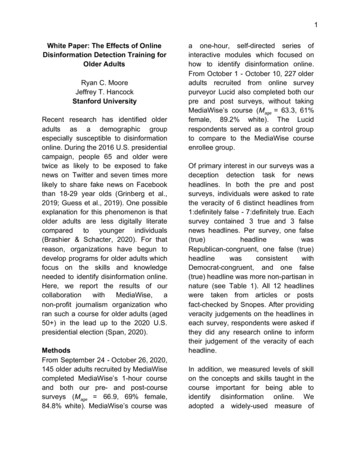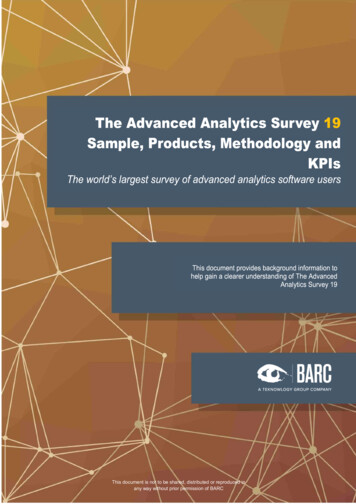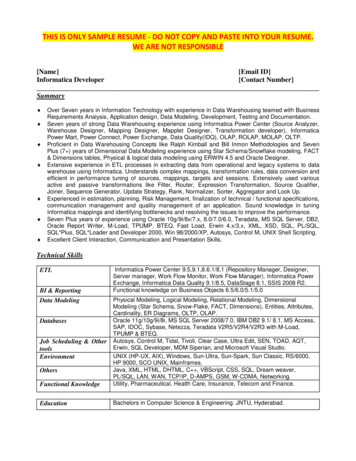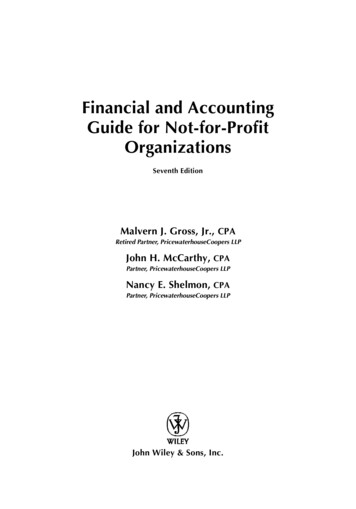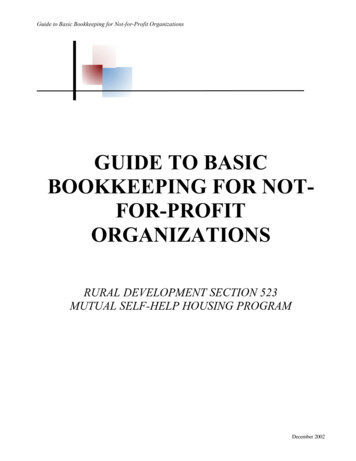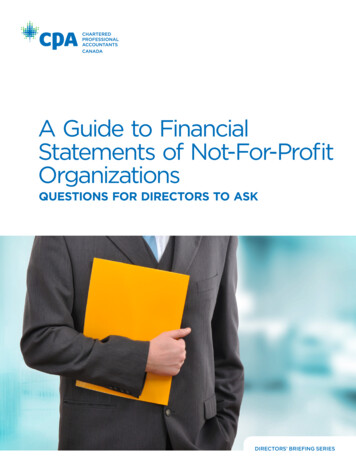
Transcription
Policy Study 414March 2013It’s Not Personal: The Dangers ofMisapplied Privacy Policies to Search,Social Media and Other Web ContentBy Steven TitchProject Director: Julian Morris
Reason FoundationReason Foundation’s mission is to advance a free society by developing, applying and promoting libertarianprinciples, including individual liberty, free markets and the rule of law. We use journalism and public policyresearch to influence the frameworks and actions of policymakers, journalists and opinion leaders.Reason Foundation’s nonpartisan public policy research promotes choice, competition and a dynamic marketeconomy as the foundation for human dignity and progress. Reason produces rigorous, peer-reviewedresearch and directly engages the policy process, seeking strategies that emphasize cooperation, flexibility,local knowledge and results. Through practical and innovative approaches to complex problems, Reasonseeks to change the way people think about issues, and promote policies that allow and encourage individuals and voluntary institutions to flourish.Reason Foundation is a tax-exempt research and education organization as defined under IRS code 501(c)(3).Reason Foundation is supported by voluntary contributions from individuals, foundations and corporations.Copyright 2013 Reason Foundation. All rights reserved.
Reason FoundationIt’s Not Personal: The Dangers ofMisapplied Privacy Policies to Search,Social Media and Other Web ContentBy Steven TitchProject Director: Julian MorrisExecutive SummaryMillions of people have come to understand the Internet as a new media platform. For thegovernment, unfortunately, basic comprehension of the business models and consumer demandthat drive this platform remains elusive.Traffic and usage statistics show the public is enthusiastically embracing the Internet as a two-wayinformation medium. Facebook, the leading social network, says it reached 1 billion members inOctober 2012. But the traction other sites are gaining shows that interest in social networking ishardly plateauing. Pinterest, launched in March 2010, has reached 25 million U.S. users.Prognosticators are heralding it as the next Facebook.1But while social media and other tools for consumer information-sharing on the World Wide Webspeed ahead, lawmakers and regulators are doing everything they can to slow them down.Congress, the Federal Trade Commission and the White House itself, responding to concerns fromprivacy advocates, which include groups such as the Electronic Privacy Information Center(EPIC), Free Press and Consumers Union have been pressing for more government oversight of theway websites collect and use information that users provide—either directly through userinteraction or indirectly through special programming embedded in Web browsers and websites.Most of the free, Internet-based services that consumers take for granted are supported byadvertising. At issue is the way websites collect and statistically analyze information to matchadvertising to users’ interests. Nearly everybody agrees that consumers have the right to knowwhat type of data is being collected, how it is being used, and, if they wish, the right to withholdthis information, or “opt-out”—and the market has met this demand on its own. The government,
nonetheless, is contemplating more sweeping steps, such as those now advocated by the WhiteHouse, for example the vaguely worded “Online Privacy Bill of Rights” that would place legallyenforceable restrictions on how websites collect and use consumer information, pushing the U.S.toward a stricter regime akin to the European Union’s Privacy Directive. If adopted, theserestrictions could present a host of unintended consequences for consumers, websites, and theoverall environment of the Internet, and potentially short-circuit the current Internet serviceenvironment where freely available information has become the norm.Web advertising platforms are based on the mining and correlation of information that a usersupplies to draw conclusions about the likes, tastes and purchasing tendencies of that individual. Ina way, this is simply a refinement of techniques marketing and sales persons have used fordecades, if not centuries.In the offline world, most information collection and analysis is done in the background. Ownersof small businesses, be they barber shops or bookstores, grow to know regular customers wellenough to anticipate their needs. Larger companies, such as restaurant and supermarket chains,track sales of specific items and use the data to make decisions about purchasing and inventory,and even to tailor brands or menu items to local tastes. Because on the Internet targeting techniquescan assert themselves quickly and dramatically—as in the form of directed advertising—somebelieve these information-gathering and analytics techniques to be an invasion of privacy and wantto prohibit them or put steps in place to render them less effective.These calls for regulation, however, fail to account for the benefits analytics have for users.Targeted and behavioral advertising techniques help consumers identify sellers and gain moreinformation about products, prices and differentiators that much more quickly. In addition, targetedadvertising results in a more cost-effective market. Sellers can identify and serve potential buyersfaster and more effectively and avoid devoting resources to more scattergun approaches. Theseeconomic efficiencies help lower prices.That’s why legislation and policies to regulate or prohibit the consensual sharing, collecting,analysis and correlation of consumer information by websites will undermine Web commerce,consumer choice, a growing base of free entertainment and information services and applications,and lead to other consequences for consumers and U.S. competitiveness.Websites can collect information in four principal ways:§ Directly from user input—that is, from information supplied by the user in subscriptionforms, interactive applications such as website polls, and, most recently, throughinformation, preferences and “likes” on social networking sites like Facebook, Google ,and Pinterest.§ Through embedded software codes, called “cookies,” that websites place on Web browserslike Microsoft Explorer, Mozilla Firefox, Google Chrome and Apple’s Safari.§ Through “clickstream data,” which record user activity on a website.§ Through user searches and Web browsing history.
All of this information has a role in supporting Web advertising. And just as with other media,advertisers need a way of measuring the effectiveness of their ad purchase. Whom is their adreaching? Are these users the right targets? Is it leading to purchases?Targeted and behavioral advertising isn’t just something big companies like Google and Facebookdo. It is a business model that serves as the foundation for most of the free or inexpensive Webbased information and entertainment users currently enjoy. The imposition of a top-down regimethat limits the choice individuals have when it comes to sharing information would have serious, ifnot fatal, consequences for this model.These proposed laws and regulations are being driven by genuine concerns about privacy and theloss of control some users feel when it comes to their personal information. Indeed, privacy lawsare generally good when they protect individuals from theft and fraud, and in the process ensurethe integrity of trusted systems—banking, health care, education and so forth. On the other hand,privacy regulation becomes troublesome when it tries to influence or change behavior, substitutingthe consumer’s informed choice with the preferences of the government.Unfortunately, that is the trend in much of the proposed regulation of search, social media andother websites that gather user data. Suggested solutions have fallen into several groups, and rangefrom light to heavy in their degree of intrusion and coercion regarding consumer interaction withwebsites. Broadly categorized they are:§ Mandatory or optional Opt-in/Opt-out choices regarding the disclosure of certaininformation;§ “Do Not Track” legislation that prohibits websites from collecting user browser dataregardless of whether consumers consent;§ Agreements between the government and major Web companies on user privacy and thecollection and use of user data;§ Creation and enforcement of “Online Privacy Rights;”§ Outright privacy directives that regulate the collection and use of user data, as seen in theEuropean Union.Each of these approaches presents differing degrees of intrusiveness, but all presume to enforce atop-down, statutory regime. The problem is that technology does not lend itself to slow-moving,one-size-fits-all regulation, but instead thrives when best practices are allowed to bubble up fromconsensus. Best practices can also adapt as technology develops and user perceptions and habitschange.The establishment of online privacy “rights” is of particular concern because, as drafted by theWhite House, they are vague and, if legally codified, stand to short-circuit innovation andexperimentation because of the compliance concerns they will raise. Furthermore, the White
House’s privacy rights track closely with the EU’s Privacy Directives, which evidence showsadversely affected advertising effectiveness. An analysis of the Web advertising market undertakenby researchers at the University of Toronto found that after the EU Privacy Directive was passed,online advertising effectiveness decreased on average by around 65% in Europe relative to the restof the world. The authors go on to conclude that these findings will have a “striking impact” on the 8 billion spent each year on digital advertising: namely that European sites will see far less adrevenue than counterparts outside Europe.As advertising revenues are slowed, so will the growth of sites that use the targeted ad model,which include services that are the most innovative and provide the most consumer value.An immediate consequence would be the decline of the number of free content, information andservices available on the Web. Regulation would add a new compliance burden on any start-uphoping to use targeted ads, creating an obstacle that would affect capitalization requirements atbest and kill the business model for free services at worst.The “Mother May I?” nature of the regulation would pre-empt experimentation with differentbusiness models that would employ user information in new ways. This is a major risk of anyregulation or legislation in technology, an area that is constantly changing and evolving, and wheresuccess and survival often hinge on out-of-the-box thinking.Regulations against information-sharing also undermine the community-building character of themedium. One of the reasons people go online is to meet and interact others who share interests andpassions. Individuals with unique interests—from bird-watching to numismatics to Axis & Alliesgaming—can connect with far more like-minded individuals than they might in their owngeographic community. These communities in turn build knowledge bases that the generalpopulation of users can turn to from time to time. The ripple effect of the proposed regulationwould constrain this information-sharing as well, keeping people from using the Internet for thevery capabilities that serve this population.Finally, much of the privacy regulation being proposed is purely precautionary. It is based onspeculative “what if” and “what might” scenarios that imagine potential harms but fail to identifyany extant ones. Market forces, however, have already forged a powerful check when companiesoverstep what customers see as defined privacy boundaries. Although lawmakers find this trialand-error process cumbersome, it is necessary because user attitudes regarding information-sharingare complex. There is a documented “privacy paradox,” that is, multiple studies have found thatwhile users express concern about the sharing and use of personal information on the Web, they goahead and do so anyway. The only way websites are going to resolve this paradox is throughexperimentation. In the course of their testing, they are bound to overstep. When popularcompanies like Google and Facebook have done so, they have faced a rapid backlash from usersthat forces proper corrective action more swiftly and powerfully than could possibly be achievedby regulation. In each case, this has been followed by an apology and retrenching, and thecompanies have retained customer goodwill.
The privacy paradox notwithstanding, recent data suggest that users are aware of their privacyoptions and making use of them. Users appear willing to take responsibility for managing theirown privacy preferences. A new study from the Pew Research Center’s Internet & American LifeProject, published in February 2012, found that a majority of social network site users (58%)restrict access to their profiles. Women are significantly more likely to choose private settings—only 20% said their main profile is set to be completely public. Women who use social networkingsites are more likely than men to set the highest restrictions (67% vs. 48%).2While half of social networking site users say they have some difficulty in managing privacycontrols, just 2% said it is “very difficult” to use the controls. The balance—49%—said settingprivacy controls was “not difficult at all.”Examination of the technology, business models and consumer research supports a light-handedapproach to regulation of websites with regard to their collection and use of personal information.Technology moves too quickly for legislation to keep up. Entrepreneurs need to have freedom toexplore new business models without looking over their shoulder for fear of a governmentobjection. Finally, consumers show a willingness to exchange information about their tastes andlifestyles in return for the tangible value of free services.The case for allowing free market models to shape the way consumers choose to interact withwebsites can be summarized in five points:1. Top-down mandates slow technology innovation.Legislative and regulatory directives pre-empt experimentation. Consumer needs are bestaddressed when best practices are allowed to bubble up through trial-and-error. When the laggingeconomic and functional development of European Web media, which labors under the sweeping,top-down EU Privacy Directive, is contrasted with the dynamism of the U.S. Web media sector,which has been relatively free of privacy regulation, the difference is profound. U.S. Webentrepreneurs continue to push the envelope in terms of creativity and innovation. Facebook,LinkedIn, Groupon, Foursquare and Pinterest are just a handful of popular sites that have emergedsince 2004, just as the EU Policy Directive was taking effect across the continent. It is telling thatno analogs to these ventures have arisen in Europe. Additional research shows that overall, theeffectiveness of Web-based advertising is far lower for sites in Europe, where targeted advertisingis regulated, than it is in the U.S.2.Consumers push back when they perceive that their privacy is being violated.Google and Facebook, two of the largest and most visible Web-based enterprises that collect userdata, have felt user backlash on several occasions when they have changed their privacy policiesor, in the eyes of users, disregarded them. In every case, the company reacted far more quicklythan the government could. When the FTC did finally render judgment, it could find no harms
worthy of fines or sanctions. Just as important, despite their missteps, neither Facebook nor Googlelost much in terms of user goodwill. Their CEOs apologized and promised to do a better jobcommunicating privacy policy and any changes. They serve as excellent examples of how themarket can correct itself when consumers express displeasure.3. Web advertising lives or dies by the willingness of consumers to participate.As a corollary to the point above, Web sites that derive revenues from targeted advertising must besensitive to user perception because if users believe they have been exploited, they will stopvisiting the site. MySpace is an example of a social network that once dominated its space. But itsreputation as being a largely unsupervised community for teens, its troubling susceptibility tophishing, malware and spam, as well as (overblown) reports of its being an easy source ofpornography and a haven for child predators were ultimately fatal. In early 2008, MySpace wasstill the most visited website in the world. As of March 2012, MySpace ranked 160th on Alexa,another Web metrics site.34. Contractual arrangement allows customers to customize their unique privacy wishes.Privacy concerns are best addressed through clear policies and contractual agreement. Well-craftedlegislation can endorse this, yet still leave room for users to set their own privacy parameters inline with their own preferences.Privacy policies can be enforced via the FTC or the courts, the latter being preferable. This processhas worked well in the area of information security, and courts have found retailers such as T.J.Maxx and banks such as Belmont Savings Bank in Massachusetts liable for consumer loss becauseof data breaches. Opt-in, Do Not Track and privacy bills of rights are all about substitutinggovernment mandates for individual discretion. They do not strengthen or expand on any currentlaws against online fraud or theft, which by themselves are quite strong.5. Greater information availability is a social good.An unfortunate aspect of the call for privacy regulation is the a priori assumption that commercialinformation-gathering and targeted advertising are questionable practices from which consumersneed to be protected. On the contrary, information-gathering in all areas of market research, butcertainly audience research in media, has a long history. Consumers are willing to provideinformation about age, gender, income, lifestyle, preferences and tastes in return for morestreamlined and customized information about products and services which might interest them, aslong as they are satisfied that the information they provide will be confidential or anonymized.There are wider social benefits when more information is available to buyers and sellers. For one,limited resources can be allocated better. Suppliers can know which regions of the country will
have the greatest demand, and adjust their distribution networks to meet it. Product goes to whereit’s most needed; better value is derived from transportation costs, and there is less waste. Theseare just basic examples. Multiplied across global markets and applied to hundreds, if notthousands, of information parameters and variables—all processed at very low cost—fostersproductivity and wealth throughout the economic ecosystem. This is why it’s best to derive privacypolicies from a strong and constantly evolving knowledge base of best practices, rather than tocodify them into laws that, in their government’s failure to foresee innovation, will unintentionallypreclude it.
Reason FoundationTable of ContentsIntroduction . 1Ways Websites Gather Information. 3User Input . 4Cookies . 4Clickstream Data . 5The Role of Search Engines . 6The Role of Social Networking .
Pinterest, launched in March 2010, has reached 25 million U.S. users. . (EPIC), Free Press and Consumers Union have been pressing for more government oversight of the . believe these information-gathering and analytics

